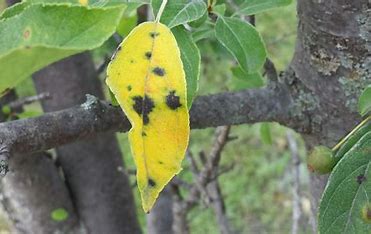Is your crabapple losing leaves? Apple scab may be to blame

MACOMB, Ill. — The problem with many plant diseases is once you notice them it’s often too late. That’s especially true with our trees.
We often don’t gaze at the canopies of our trees looking for problems. The typical homeowner won’t notice disease or insect damage until visible symptoms surpass 10 percent of the canopy. One tree disease that seems to sneak up on us every year is apple scab.
Many who grow apples or crabapples (Malus spp.) have likely seen this disease before and may or may not know it. Apple scab is so common that plant pathologists expect to see it every year. In 2023, our spring started mild, turned hot, and then cooled down for several weeks. The prolonged cool weather is a good indicator of stronger apple scab pressure on our crabapples and apple trees.
Apple scab (Venturia inaequalis) is a fungus that infects apples, crabapples, mountain ash, pear, and Cotoneaster. Symptoms typically start on the underside of leaves, forming light brown to olive green lesions that are irregularly shaped. As the infection progresses the lesions become more circular with the spots eventually turning black or brown. Infected tissue will thicken creating a bulge on the upper leaf surface. Leaves may curl and scorch at the margins.
Apple scab can progress to the leaf petioles and fruit pedicels, causing early leaf and fruit drop. As the canopy becomes sparse in mid-to-late summer that’s often when homeowners take notice. Unfortunately, by that time it is too late to treat the tree.
While not generally fatal to an infected tree, there are some options for dealing with apple scab.
- Plant resistant varieties. This is the most desirable means of managing apple scab in the landscape. Keep in mind in excessively wet years even resistant varieties may show signs of this disease.
- Keep the area beneath the tree clear of infected leaf residue. Removing fallen leaves can be beneficial. Note that apple scab is so common and disperses so easily that infection is likely to reoccur. In apple orchards simply mowing the fallen leaves has been shown to reduce the following years severity of apple scab.
- Promote a healthy tree. Mulch with arborist wood chips and water the tree in times of drought.
- Use preventative fungicide sprays. Fungicides labeled for apple scab control include mancozeb, chlorothalonil, calcium polysulfide, copper sulfate, or potassium bicarbonate. Read and follow all label directions. Most of these sprays are preventatives, not curatives. So you will need to spray before the fungus occurs. Don’t waste money spraying infected leaves.
Once the leaves start to yellow and drop, it is too late to protect the tree. If all this fungicide spraying sounds like a chore, but a defoliated tree in August is an eyesore in your landscape, you may need to prune horizontally at the soil line thusly removing the tree and replanting with a resistant variety. There are several resistant crabapples including the popular “Prairiefire.”
Miss Clipping Out Stories to Save for Later?
Click the Purchase Story button below to order a print of this story. We will print it for you on matte photo paper to keep forever.

